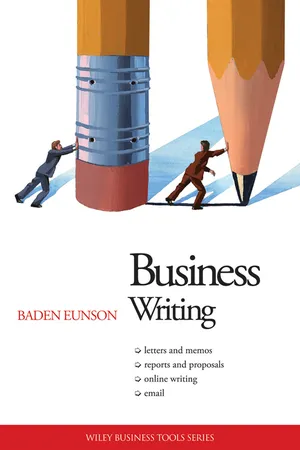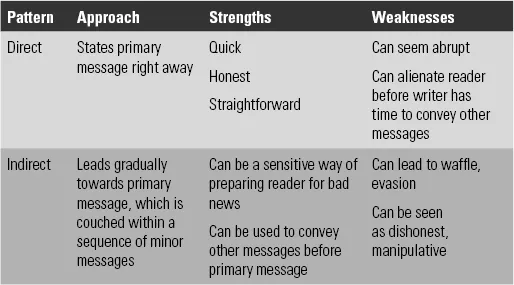
eBook - ePub
Business Writing
Baden Eunson
This is a test
- English
- ePUB (mobile friendly)
- Available on iOS & Android
eBook - ePub
Business Writing
Baden Eunson
Book details
Book preview
Table of contents
Citations
About This Book
The ability the write well in professional situations is a much sought-after and all too rare skill. Business Writing takes a hands-on approach to help you excel in writing a range of hard-copy and electronic documents.
Learn how to write effective:
- letters
- memos
- emails
- reports
- website text.
Expert communicator Baden Eunson shows you how to design documents, employ persuasive techniques and how to recognise (and foil) the mind games some people play. Also, discover how to avoid the pitfalls of planning and editing documents to become a proficient and fluent writer.
Effective writing is a skill that everyone can develop and is a vital attribute for those who wish to succeed in the highly competitive business world.
Frequently asked questions
At the moment all of our mobile-responsive ePub books are available to download via the app. Most of our PDFs are also available to download and we're working on making the final remaining ones downloadable now. Learn more here.
Both plans give you full access to the library and all of Perlego’s features. The only differences are the price and subscription period: With the annual plan you’ll save around 30% compared to 12 months on the monthly plan.
We are an online textbook subscription service, where you can get access to an entire online library for less than the price of a single book per month. With over 1 million books across 1000+ topics, we’ve got you covered! Learn more here.
Look out for the read-aloud symbol on your next book to see if you can listen to it. The read-aloud tool reads text aloud for you, highlighting the text as it is being read. You can pause it, speed it up and slow it down. Learn more here.
Yes, you can access Business Writing by Baden Eunson in PDF and/or ePUB format, as well as other popular books in Persönliche Entwicklung & Karriere. We have over one million books available in our catalogue for you to explore.
Information
Chapter 1
Letters 1 — what they are and how to write them
One of the most important elements of business writing is writing letters. You may ask, ‘Why should I bother with such an old-fashioned form of communication as letters?’ There are many reasons why letters are still utilised; read on to find out why.
Letters — when, why and how
Letters are one of a number of genres we use as communicators. With the rise of email, it is commonplace to hear about ‘the death of letter writing’ in relation to both personal and professional communication. In spite of this, the letter is still very much alive — primarily because its advantages still outweigh its disadvantages, which are listed in table 1.1 (overleaf).
Table 1.1: advantages and disadvantages of letter writing as a channel of communication
| Advantages | Disadvantages |
| Official status: many recipients will take a letter, especially on letterhead, more seriously than a fax or email | Time cost. it takes longer to plan, draft, write, edit and send a letter, via mail or courier, than to use email |
| Touch and keep: a letter can be handled, filed and stored without loss of quality | Financial cost. letters involve costs in labour, materials (printed letterhead is costly), postage/delivery costs, and creation and storage of copies |
| The personal touch: a signed or handwritten letter carries more weight and consequence for many recipients than a fax, email or telephone call | Slow delivery: letters sent via ‘snail mail’ involve longer delivery times than faxes or emails |
| Slow delivery: the weakness of relatively slow delivery can be a strength if the creation process leads us to take more care in the message’s production — putting more thought into the words and ideas on the page |
You don’t write because you want to say something, you write because you’ve got something to say.
F Scott Fitzgerald
New technology has increased our channels of personal and business communication, which now include physical and electronic methods such as letters, memos, reports, faxes, emails and SMS (short message service) via telephones. Technology changes, but certain principles of communication remain constant. We should never forget the 8Cs of written communication (see table 1.2).
Table 1.2: the 8Cs of written communication
| As writers, we need to be ... | How? |
| 1 Clear | The document should send a plain and unambiguous message It should not confuse or patronise the recipient It should aim to prevent or fix, not cause, communication breakdowns |
| 2 Correct | The message should contain no factual errors All words, especially proper names, should be spelt correctly |
| 3 Comprehensive | The message should include all critical information The recipient should not need to seek clarification because the writer has made assumptions about the recipient’s knowledge |
| 4 Concise | The message should be only as long as it needs to be The message should be only as complex as it needs to be |
| 5 Credible | The message should be conveyed in a professional way Any opinions should be supported by facts |
| 6 Considerate | The message should reflect the ‘you’ attitude (that is, a concern for the reader’s needs and interests, rather than the writer’s). The ‘you’ attitude is: Polite — demonstrating good manners and tact Practical — answering the recipient’s question ‘What’s in it for me?’ (that is, it gives the recipient an incentive to respond to, rather than ignore, the message) (see p. 50) |
| 7 Courteous | The message should reflect respectful and civilised values It should not give the reader cause to take offence, or to take legal or retaliatory action |
| 8 Conscientious | The message should meet the highest ethical standards It should contain no material unethically taken from other sources |
The discipline you use to write things down clearly is the first step in making them real.
Lee lacocca
Approaches to writing letters
Different approaches may be taken when writing letters, depending on their purpose. For example, it’s useful to distinguish between direct and indirect approaches to the topic. Each pattern has its strengths and weaknesses.
The direct approach in a business letter is appropriate; for example, when we are able to give our readers what they want, while a more indirect approach may be taken when we are unable to do so or when conditions apply. We need to keep the direct/indirect distinction in mind when creating documents for different situations and recipients. Table 1.3 lists the direct and indirect patterns of letter organisation.
Table 1.3: direct and indirect patterns of letter organisation

Before I turn to some of the techniques involved in composing letters, I will briefly look at matters of process — presentation, layout, formatting or information design, and conventions of wording and expression.
The elements of a letter
A letter contains various elements, some of them essential, others optional, depending on the circumstances. Within many organisations, these questions are determined by house-style conventions — ‘the way we do things around here’. Communication conventions develop over time and vary considerably according to the organisational culture. People in organisations may often be unaware of the specific house-style conventions under which they operate until:
- someone decides it would be a good idea to write a house-style manual
- the organisation merges with another and is confronted with a different culture and with conventions that differ slightly or radically
- technological changes prompt writers to challenge current conventions.
Much of this section on document conventions is about details. Details can be boring, but when writers get one or several details wrong, the impact and effectiveness of the document is compromised. Attention to, or neglect of, detail sends out a message of its own, separate from but linked to the main content of the communication. Table 1.4 details the essential and optional parts of a letter.
Table 1.4: essential and optional parts of a letter
| Essential | Optional |
| Sender’s address | Subject line |
| Date | Attention line |
| Recipient’s name and address | Security heading |
| Salutation | Reference details |
| Body of letter | Document initials |
| Close | Sender’s contact details |
| Signature b... |
Table of contents
- Cover
- Contents
- Title
- Copyright
- Preface
- Introduction
- Chapter 1: Letters 1 — What They are and How to Write Them
- Chapter 2: Letters 2 — Giving Good News and Bad News
- Chapter 3: Letters 3 — Persuading
- Chapter 4: Memos
- Chapter 5: Reports
- Chapter 6: Online Writing — Emails and Websites
- Conclusion
- Appendix
- Notes
- Glossary
- Index